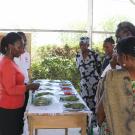Abstract: Amaranth is a leafy vegetable with high nutrient content which is sensitive to temperature and low relative humidity. Delays in shipment to market may result in significant losses, therefore improved packaging to minimize mechanical damage and reduce moisture loss are desirable. Amaranth was stored in three types of consumer packages, bunches, clamshells and thin plastic bags, within vented plastic crates. Pallet loads were either covered with insulated material or not, while awaiting transportation. Results indicated covering pallets improved the color and overall quality while reducing weight loss and wilting. Covered crates had a “good” (7.6/9.0) overall quality while uncovered averaged 5.5/9.0 or “moderate” quality. There were significant differences in consumer package type, with the bagged amaranth having almost “excellent” quality (8.8/9.0) compared to “good-fair” quality in clamshells (6.2/9.0) and “poor-fair” quality in the control bunches (4.7/9.0). Amaranth stored in thin plastic bags was better in quality and color, with less weight loss and wilting, however, temperatures at the end of six hours of storage were higher and this may lead to microbial growth. Storage of amaranth in thin bags or clamshell packages, within plastic crates covered with insulated pallet covers while awaiting shipping resulted in improved overall quality and color.
Wheeler, L., L. Kitinjoa, D.M. Barrett. 2015. Use of insulated covers over product crates to reduce losses in Amaranth during shipping delays. Agriculture. 5(4):1204-1223. doi:10.3390/agriculture5041204

